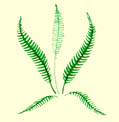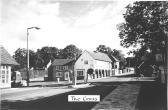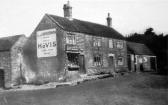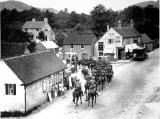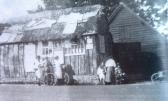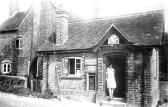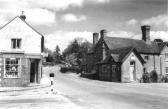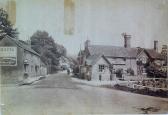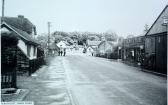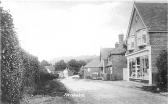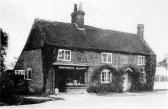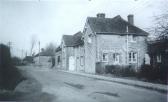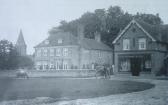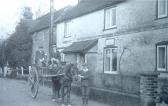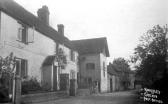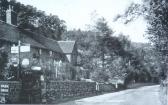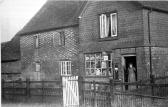The Fernhurst Society
Fernhurst in Living Memory, part 3
Shops and shopping in Fernhurst in the early 20th century
by Christine Maynard, 2004.
Information gathered from various sources, including the Fernhurst Archives, Edie Lucas, Brian Silver, Mollie Brittain, Olive Gilbert, Nigel Headland, Margaret Cole, Mercy Gandy, Alf West, Bob Larbey, John Rickman, Kevin Hall and Margaret Hutchinson.
Click on any image to see a larger version (note: the larger images
may take a minute to download over slow internet connections).
It’s a Saturday night in Fernhurst, sometime between the wars. We’ve just been paid, the shops are open ‘till 9pm, so let’s go down to the Cross, meet our friends and go shopping!
Everyone used to meet at the Cross and stay and chat with each other in the summer evenings. In the winter it was a great treat when you were little to go there in the dark with torches and lanterns.
Let’s stop at Woodman’s first. It was a baker’s and grocer’s but also sold cornmeal, paraffin and many other lines as well as selling gold syrup straight from the barrel into customer’s own jars. Bread was delivered round the village late at night and placed in containers left out for the purpose. Cary Woodman, a funny, short, little lady, ran it with her two brothers. TOP
In 1927 James, known as Jimmy, Cole bought it from her and installed his brother-in-law James Newman, who was married to his sister Edith, to run it. Edith also ran a small tearoom on the upper floor. They carried on the grocery business and baked bread and cakes on the premises until well into the 1950s, with daily deliveries.
When Jimmy Cole had new staff there, especially impressionable young girls, they were always told to be out promptly before the shop was locked up because the ghost of Cary Woodman, the previous owner, would walk. It wasn’t true at all, he just liked to tease them.
During the second world war they kept pigs round the back. The shop had an acre of land, which is now Cherrylands Close. In the 1940s Jimmy’s son Ron worked as grocer, baker and because the family also owned the Post Office he was also Postmaster. At that time the telephone exchange was housed in the Post Office and he would often be on duty overnight for the telephone – no direct dialling then! – then back over to make the bread. There was also the newsagency to keep tabs on over the road.
The small, pebbledashed building, now part of Blackdown Press, has a long and chequered history, By the early 20th century it was very ramshackle affair of timber and thatch, but doing duty as the records office where the parish clerk worked, and belonged to the Cowdray Estate. Jimmy Cole and Jack Lambert went into partnership in 1925 and turned it into the village’s first newspaper shop. Before that, the papers had been delivered from W H Smith in Haslemere by men on bicycles. Within two years he had bought Jack Lambert out.
Jimmy Cole died in 1958 but gave the reins over to his son Ron in about 1953. Ron was a newsagent for about sixty years. His father was so proud of being able to send him to Midhurst Grammar School as a boarder but Ron hated it so and persuaded his father to let him leave when he was 14 and go into the business.
One former shop assistant there remembers that mice used to get in at night and get into the Easter Eggs. Mr Cole said to her ‘Olive, I’ve got some traps; for every mouse you catch I’ll give you sixpence.’
When the current newsagents’ was built in 1968, the hut became a fishing tackle and clothing shop run by Leslie Wooldridge and then an antique shop, first run by W E Stephens then given a coat of pink emulsion and run by Mr and Mrs Charles Barkman.
The building behind, an old carpenter/joiner's workshop, was taken over by the Co-op in 1927, who rebuilt it into a substantial single storey brick building
The Co-op was a much-loved and taken for granted institution for 53 years and there were petitions and protests when it was closed down.
In the late 1980’s the building housed The Curry Club, a mail order company that sold curry spices and accompaniments for a couple of years, then it was reverted to its previous incarnation as a workshop when Europress arrived, and finally to its present owners, Blackdown Press, who added the upper storey.
Ron Cole acquired the Post Office in 1940. Edie Lucas wrote quite a detailed history of Fernhurst Post Office for the parish magazine in 1985. The first Postmaster was George Smith, who took up his position in 1860 and served for 63 years. He was succeeded by his daughter Miss Zoe Smith who worked there until 1940. Many locals helped in the Office in the early years, including Doris Carpenter, Annie West, Dora Rapson, May Evans, Betty Greenfield and Mr Headland. Most of these people manned the telephone exchange. 14 year old Nigel Headland used to deliver telegrams on his pushbike after school.
The 1940s was the busiest time in the Post Office’s history due to the great increase in the population of the village by evacuees from London. The Telephone Exchange had to be manned night and day to cope with the increased calls, especially as the Fernhurst Camp, where Syngenta and Nicholsons now are, was occupied by the 14th Field Survey Company plus Canadian units, which were also encamped in the surrounding fields and on Henley Common.
The position of the Post Office door was changed because an American or Canadian tank coming from Chapel Street, now Vann Road, and intending to go towards Haslemere failed to negotiate the corner and almost entered the Post Office.
Ron eventually handed over to Mr and Mrs Kelly and about that time a new Telephone Exchange was built behind the Spread Eagle, near where the Youth Club is now.
Edie became sub-Postmistress from 1964 until 1974, followed by Mr and Mrs Ball, who also stayed in post for ten years. They were able to develop a small business as well as run the post office.
Just north of the Post Office was the wheelwright’s shop, currently under conversion. At one time it was a glorious secondhand cum antiques emporium run at first by Colin Lambert and Bob Begent, then with Steve Brown on a Saturday morning. On the opposite side of the road, where you go into the Youth Club, there used to be a blacksmith’s shop.
A little further up stood Lambert’s barber shop next to the old Spread Eagle (where Taverners Court now stands). Mr Lambert was also the postman. Then there was Larbey’s, a sort of ironmongers. Mr Larbey was a little, tiny, short man. If you were a devotee of the pub and wanted a shave or a haircut (or both) you took care to go there in licensing hours. You bought your pint, took it next door to the barber’s where, sipping blissfully, you awaited your turn in the chair.
There was also Mr Smithers, who sold fish, the other side of the Spread Eagle.
Hang on, we’ve forgotten the rest of the shops in Midhurst Road!
Either side of Fernhurst Club, originally the Working Men’s Institute, founded in the village in the early 20th century, were shoe menders, both called Dudman, although they were not related, and both had lost a leg in the first world war. Alec Dudman had originally carried on his business in a hut in Church Road but in the 1930’s moved to the main road, where the newsagents is now. In his day there was just a wooden hut with a sort of stable door. Fred Dudman’s shop was the other side of the Club.
Just up from there was Sid Burrow’s bicycle and repair shop, opposite Walt Paine’s garage, now Fernhurst Motor Company, but Sid moved across the road and the business became Burrows & Paine.
During the war the petrol pumps were taken over by the Americans with a black GI manning the pumps. This was quite a talking point as not many had seen one before. Walt Paine had a small workshop at the back of and under his premises where he was manufacturing top secret precision parts for detonators.
Just past the Village Hall was Chase’s Haberdashery, run by William Chase, son of Fred, of whom, more later. You could buy anything from a needle to a pair of shoes there as well as clothes for every member of the family.
Before we go along Chapel Street, let’s just look in the window at Smorthwaite’s with those big green and red bottles. It was a proper chemist where you could get your prescriptions dispensed. The shop changed hands several times, becoming variously a draper and haberdasher, National Westminster Bank (there was also a Lloyds), then Bricks ‘n Mortar, the Cat’s Whiskers Beauty Salon and now a shop window for Bradford & Bingley Estate Agents.
The main shop along Chapel Street was Varnses, where the pharmacy is now.
The shop was staffed by Ezra Varns, his wife and the family of four girls and one boy – Florrie, Nellie, Bertha, Edith and Ernie. Ernie baked the bread and delivered the groceries. The family were Cokelers, a nonconformist religious sect and the women always wore long black skirts and black blouses. They used to go off in their black bonnets on a Sunday morning and go to Northchapel to attend services. They were particularly known for their kindness and courtesy. They also baked particularly good lardy rolls!
A bill from 1939 describes their business as Grocer and Draper, Household Furnisher, China, Earthenware, Boot & Shoe Stores. At one time there was an entire bedroom suite in the window.
This picture shows part of Vann Road in 1949, when the house in the foreground was the home of the Pitt family. They also baked their own bread and sold all sorts of things, including drapery and socks. The entrance to ‘Table Works’, founded in the early 1930s, which became ‘Plastic Works’ then ‘United Moulders’ ran between Varnses and the next house ‘Kentmere’ and now leads to Nappers Wood.
There was also a butcher’s run by Mr Moore, where Adams Stevens Ward now is.
Let’s go back to the Cross. Going down Church Road we come to Mr Denyer, the butcher. His shop is now called Glebe House. He was a dear old fellow Mr Denyer, according to Edie Lucas, together with his assistant Mr Rapson. They used to have big vats of salt beef and made the best sausages for miles around.
George Larbey recalls that as his father wasn’t very well paid, his mother would have to go along to Denyer’s after 5pm on a Saturday and for a shilling she’d buy the scraps of meat left over, some of which would have been in the sawdust most of the day.
At one time the room above was used as a tailor’s shop.
Also in Church Road was a dairy. Milk was bottled there and delivered in the village until about 1950.
Fernhurst’s first Post Office was in the second cottage on the right as you enter the Green from the churchyard, and the postbox in the wall of the White House garden was probably the first in the village.
Fred Chase kept a shop on the village green, which was part of the lovely house Sollers. Like Coles and Varnses, it was a general stores which sold sweets, groceries, bread, drapery, boots, shoes and clothes and delivered their goods around the area with a horse and cart. When the village school was on the green, the children used to run over to Chase’s for a pennyworth of sweets. The sweets were put into a little cone bag deftly made by hand out of newspaper.
Edie particularly remembers buying a ha’penny’s worth of lemonade powder, putting a well-licked finger in the bag and coating it with the powder and blissfully licking it clean. Do you remember marshmallow eggs and bacon? They were absolutely scrumptious!
After Chase’s closed in 1938, the children would go round the back of the Red Lion to buy sweets – and pickled onions!
Fernhurst folk could find just about everything they could possibly want as the village could also boast many other services such as taxies, a coach company, a coal merchant, which was next to the Village Hall, tea shops, guesthouses, a florist and an undertaker and even a cottage hospital and a building society.
Let’s have a quick look at Kingsley Green. The main shop there was Millses.
Margaret Hutchinson in her delightful memoir of Edwardian Childhood sums it up as it was in the 1930’s: After the death of Ebenezer Mills the shop was run by his son Harold. Little had changed over the years and bacon rashers were still cut on a hand-operated circular saw. There was not the wide choice of grocers that we expect now but what we got was very good. Harold looked after our needs throughout the war most capably, dealing with ration books, ‘points’ and the occasional off-the-ration perks as fairly as was humanly possible. He was magnificent!
There being no other communal meeting place at Kingsley Green, gossip was exchanged in this tiny shop and all the while Harold was serving customers at full speed, scribbling down their purchases in a large day-book in his unique short-hand. From this every now and then he would copy out every item and its price into one’s order book and tot up the pages of small amounts; he would then send it in. It might be months coming! Trust abounded.
The baker adjoined the shop and Harold’s brother Jack did the baking very early in the morning before milking the cows, for there was a small farm also.
Baking was done in the old country oven built into the wall and heated by faggots. There was always a large stack of these bundles of twiggy wood standing outside the back of the bakery. Mills’ bread was well–liked and they had a very wide delivery round. Often they were delivering late into the evening. Before the war delivery was done by horse and cart, after, when Harold’s son David was demobbed from the army, he drove a small van.
Edie Lucas recalls that in about 1950 Dave Mills had a big deepfreeze and he kept chickens and ice lollies and everything all mixed up together so if you wanted an ice lolly you would have to dig deep down amongst the chickens.
One of the four cottages, now set back in a layby in Kingsley Green, was a general store in the 1930s. It was became Shrimpton’s Restaurant in the late 1950s and closed just a couple of years ago.
Henley had its own shop as well, although Thayer & Son at Henley Common is a little earlier than the others we’ve looked at as it ran from around 1886 to the start of the First World War. It was one of the pair of cottages just past Ascot Timber Buildings and the Fernhurst Business Park. At that time Henley Common really was a common with just a few trees.
I will let Edie Lucas have the last word: how lovely it was in those days, a neighbourly, friendly village, abounding with kindliness, rich in its social life and beautiful.
And it’s not so bad these days either!
The Fernhurst Archives
